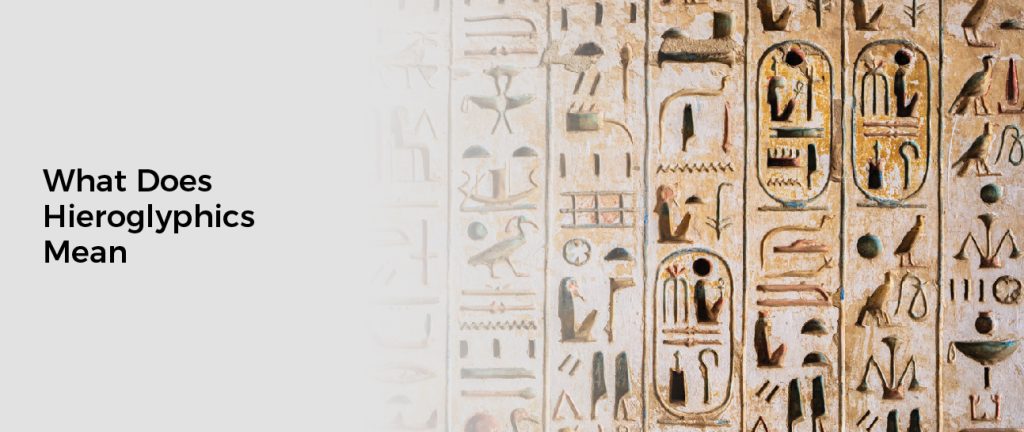What does hieroglyphics mean: A hieroglyph is a form of pictorial writing, particularly those found on ancient Egyptian monuments. Hieroglyphs can represent objects that they depict, but most often, they represent sounds or groups of sounds. At the time of the early Greek contacts with Egypt, hieroglyphs were used to differentiate older hieroglyphs from the handwriting of the day (demotic), which meant “sacred carving.”
Besides ancient Egypt, hieroglyphs can also refer to ancient Hittite, Mayan, and early Cretan writing systems. Egyptian hieroglyphs have no connection to these other scripts; Meroitic is the only certain derivative from the Egyptian alphabet.
Origins Of the Egyptian Language
The word hieroglyphics is a Greek word meaning “sacred carvings.” In ancient Egyptian culture, these inscriptions were regarded as words of the gods. They were written on temple walls, tombs, and papyrus. Eventually, they were carved in stone.
Hieroglyphics is one of the oldest writing systems. It was developed about 5000 years ago in Egypt. There are three main types of hieroglyphs.
- Triliteral Hieroglyph – This hieroglyph is composed of alphabetic characters. These characters are letters that represent the sequence of consonants and vowels.
- Phonogram -A hieroglyphic symbol that represents a speech sound. Examples include an ‘a or a ‘b.’ Ideogram anda door-bolt glyph originally represented the /th/ sound.
- Unilateral. This type of hieroglyph meansA hieroglyphic symbol read from left to right. Each glyph had a unique reading. However, over time, many of these glyphs fell into disuse.
Hieroglyphics was the foundation of Ancient Egyptian communication. It is believed that the first words were created by the god Thoth. When Thoth tried to make Egyptians wiser, he gave them writing as an aid.
Hieroglyphics: Ancient Egyptian Writing System
During ancient times, the Egyptians used various writing techniques, including hieroglyphics. This writing style, which uses symbols as pictures, allowed the Egyptians to communicate information and knowledge. It is one of the oldest known forms of written language.
The Egyptians had a system for grammar, syntax, and vocabulary. There were also phonograms, which represent a specific sound. However, they weren’t able to convey the meaning of words to people who didn’t speak the language. They needed specialized training to read these signs.
Unlike cuneiform, hieroglyphs weren’t normally used for expressing vowels. They were usually used in conjunction with another script.
Ancient Egyptian hieroglyphs are usually characterized as logograms. Generally, these glyphs are vertically inscribed on a horizontal surface and are often read from left to right. Sometimes, they are also stylized.
Hieroglyphics: Significance of Individual Symbols
The significance of individual symbols in hieroglyphics depends on the context in which they are used. Symbols can represent individual sounds, syllables, or entire words. In addition, some glyphs are determinatives or pictures that give readers an idea of the meaning of a word.
One of the most common ancient Egyptian hieroglyphs is the Ankh. This symbol represents life, power, and dominion. It was often affixed to clothing and jewelry.
Triliteral hieroglyph is another type of hieroglyph. This glyph combines alphabetic characters with vowels and consonants. Some hieroglyphs only appear at the end of a word. For example, the folded cloth hieroglyph originally had the sound /s/, but it is now written with /r/ and /f/.
The Rosetta Stone
A Rosetta Stone is an ancient stone used to decipher the lost Egyptian writing system. Moreover,French soldiers found this dark pinkish-grey granite stone in Egypt in 1799. It is about three feet 9 inches tall and 2 feet four and a half inches wide.
The Rosetta Stone contains text in Greek and Egyptian. There is also a demotic script;these writing systems are all contained in a small portion of the stone plate.
Until the Rosetta Stone was found, hieroglyphics had been thought to be a symbolic language. The ancients thought that each symbol represented a word. However, European scholars believed each glyph was an ideographic representation of a word.
Napoleon’s troops discovered the Rosetta Stone in Rashid, Egypt. They were digging the foundations of a fort. One of their soldiers, Bouchard, came across the stone.
A few months later, soldiers in the French army occupied the place where the stone was found. They began to study it. When they finished, they discovered that the stone contained Egyptian scriptures in both Egyptian and Greek.


